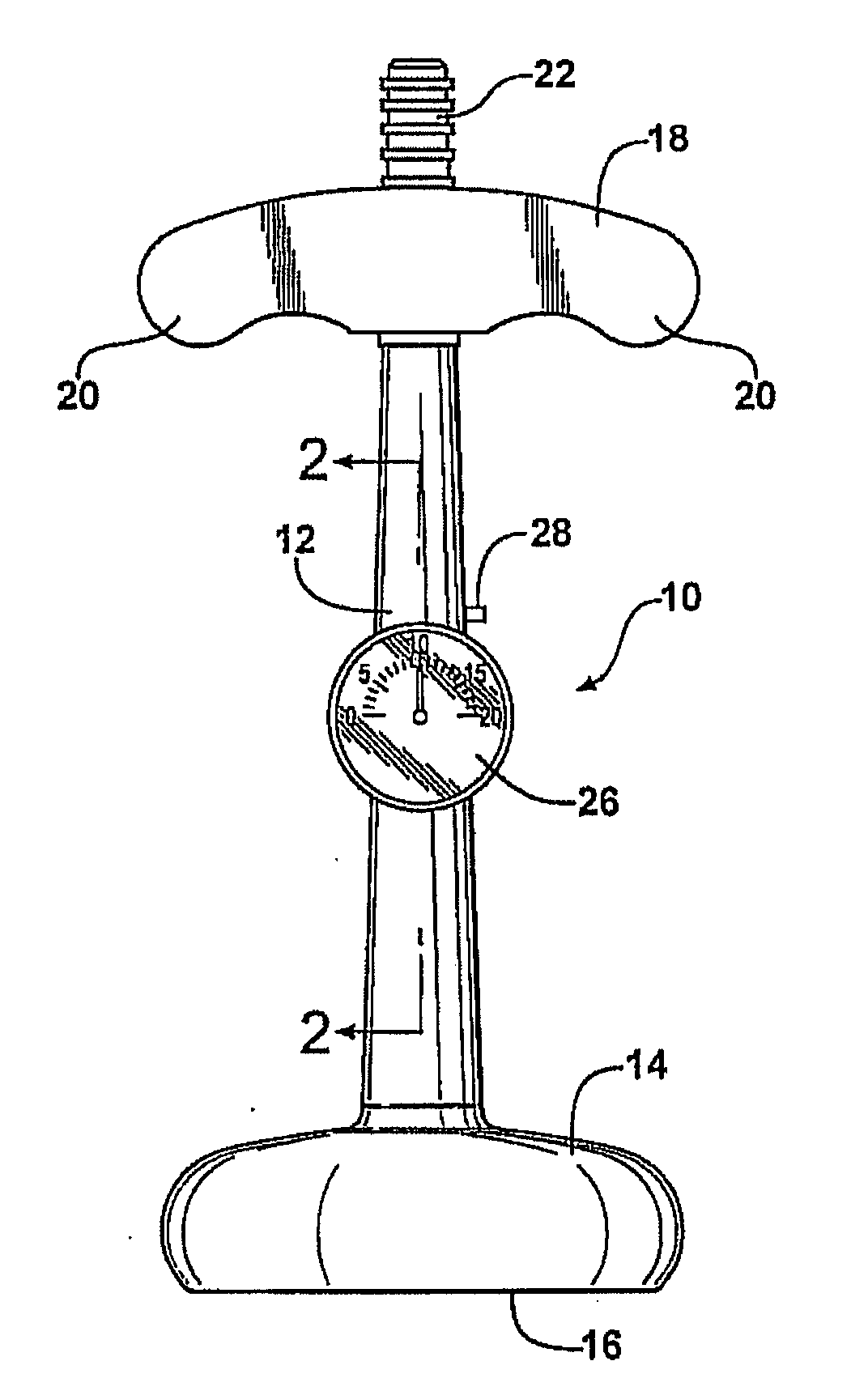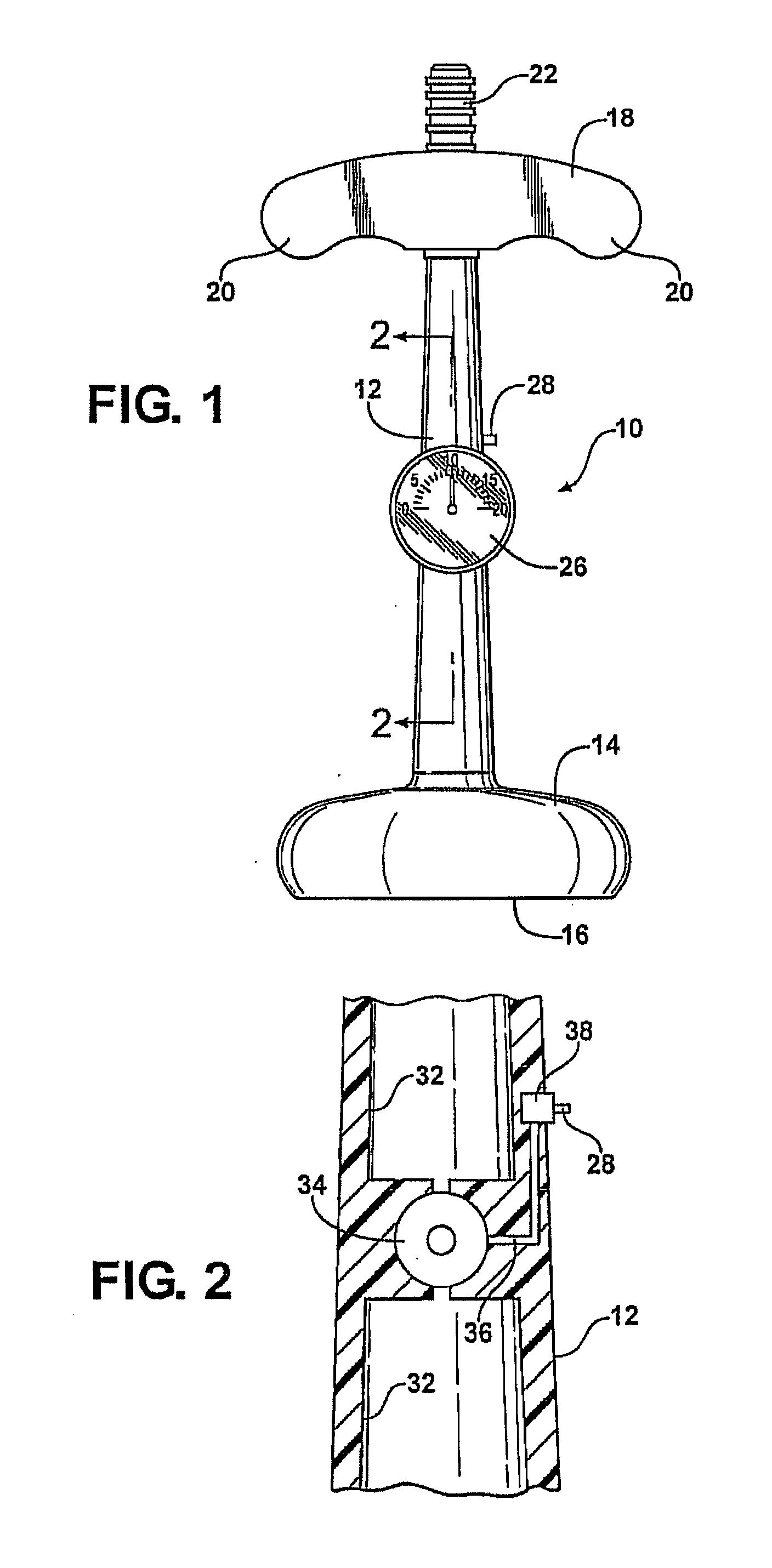Obstetrical vacuum extractor with over-traction release
a vacuum extractor and vacuum technology, applied in the field of vacuum extractors, can solve problems such as the breaking of the blood vessels connecting the fetal scalp from its underlying surfa
- Summary
- Abstract
- Description
- Claims
- Application Information
AI Technical Summary
Benefits of technology
Problems solved by technology
Method used
Image
Examples
second embodiment
[0045]the invention is illustrated in FIG. 3. The handle end of a vacuum extractor is generally indicated at 40. The vacuum extractor 40 may be identical to the vacuum extractor 10 and to the prior art in that it does not include a gauge 26 or a relief conduit 26; alternatively, in this embodiment of the invention those units are incorporated in the line connecting the vacuum extractor to the vacuum source.
[0046]As illustrated in FIG. 3, the handle 18 of the vacuum extractor 40 is equipped with a vacuum inlet port 22 of the same type as illustrated on the extractor 10 of FIGS. 1 and 2. A vacuum source 42, preferably electrically powered, draws a vacuum through a line 44 which is joined to the connector 22 by a female tubular connector 44 which slides over the male connector 22. Also connected in the line 46 is a digital gauge 48, which is preferably adjustable to a predetermined limit decided on by the attending physician, and a relief valve 50 connected to the gauge by line 52. Whe...
third embodiment
[0070]In the second aspect of the invention, shown in FIGS. 6A and 6B, a vacuum extractor similar to the one shown in FIG. 4B and discussed above is presented. With the exception of handle 130 and handle ears 138, all parts in FIGS. 6A and 6B are the same as those in FIG. 4B. Accordingly, the construction and operation of those parts will not be discussed again. Handle 130 and handle ears 138 may be formed from a suitable plastic of the required mechanical strength and configured so that ears 138 collapse or severely bend when a predetermined fraction force is reached. This would indicate that the vacuum source (not shown) must be immediately disconnected. A typical but none limiting configuration for the handle is presented in FIG. 6A. Here, handle ears 138 of handle 130 are configured to bend or collapse as a result of the narrow constrictions in the region where handle ears 138 join handle housing 158. It should be readily evident to persons skilled in the art that the use of col...
fourth embodiment
[0071]In the second aspect of the invention, shown in FIGS. 7A and 7B, a vacuum extractor 100 similar to the one shown in FIG. 4A, and discussed above is presented. With the exception of a load sensing element 180, shown in FIG. 7B separately and in FIG. 7A as part of vacuum extractor 100, all parts in FIG. 7A are the same as those in FIG. 4A. Accordingly, the construction and operation of those parts will not be discussed again.
[0072]As seen in FIG. 7B, electrical force load sensing element 180 comprises an annular ring member 186 and electrical wires 182, the latter connected to an electrical connector 184. Electrical connector 184 may be connected to an alarm element (not shown), such as a buzzer, or the vacuum source (also not shown) or both. The electronic signal of load sensing element 180 or the circuit to which it is connected, may be activated, at a predetermined over-traction force, to buzz noisily, or to release the vacuum in the vacuum source, or to do both.
[0073]FIG. 7A...
PUM
 Login to View More
Login to View More Abstract
Description
Claims
Application Information
 Login to View More
Login to View More - R&D
- Intellectual Property
- Life Sciences
- Materials
- Tech Scout
- Unparalleled Data Quality
- Higher Quality Content
- 60% Fewer Hallucinations
Browse by: Latest US Patents, China's latest patents, Technical Efficacy Thesaurus, Application Domain, Technology Topic, Popular Technical Reports.
© 2025 PatSnap. All rights reserved.Legal|Privacy policy|Modern Slavery Act Transparency Statement|Sitemap|About US| Contact US: help@patsnap.com



